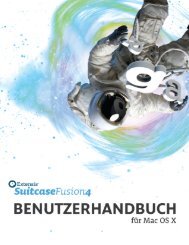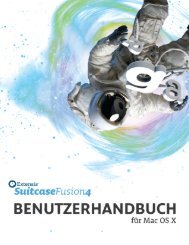Suitcase Fusion 3 User Guide for Mac OS - Extensis
Suitcase Fusion 3 User Guide for Mac OS - Extensis
Suitcase Fusion 3 User Guide for Mac OS - Extensis
You also want an ePaper? Increase the reach of your titles
YUMPU automatically turns print PDFs into web optimized ePapers that Google loves.
Working with Classifications<br />
A font’s classification (class) describes its general look in historic terms—serif, sans serif, script, old style, etc.<br />
When fonts are added to <strong>Suitcase</strong> <strong>Fusion</strong>, they are classified according to subjective design attributes.<br />
There<strong>for</strong>e, you may not agree with the classification of each font or you may feel limited by the default<br />
classification list. You can work with classifications as follows:<br />
• If you’re looking <strong>for</strong> fonts with a specific look, you can sort fonts by classification in the Fonts pane.<br />
• You can use the Find controls to list only fonts with specific classifications.<br />
• You can create smart sets to display an up-to-date list of all the fonts with specific classification.<br />
• Each font can have only one classification applied to it.<br />
• The classification applies to the font itself, so the font displays the same classification in all sets and all<br />
libraries.<br />
• You can add custom classifications, change the classification of fonts and revert to the default<br />
classification.<br />
Classifying Fonts<br />
When fonts are added to <strong>Suitcase</strong> <strong>Fusion</strong>, they are automatically assigned a classification. A font’s classification<br />
is determined by comparing the font’s family name to an internal database of font family names and their<br />
classifications. If <strong>Suitcase</strong> <strong>Fusion</strong> is unable to determine a font’s classification, two hyphens display in the Class<br />
column.<br />
The default font classification is not always appropriate or desirable, often due to the subjective nature of font<br />
classification. Although the classifications are based on conventional typographic principles, font classification is<br />
not a science. That’s why <strong>Suitcase</strong> <strong>Fusion</strong> makes it possible to change a font’s classification and create<br />
classifications.<br />
The default classifications are:<br />
Blackletter/Uncial: A Blackletter typeface, such as Goudy Text, is characterized by medieval or<br />
old English lettering, with ornate capitals, roughly diamond-shape serifs, and thick, mostlyvertical<br />
strokes. Uncial, generally perceived as Celtic or Irish, is also an archaic <strong>for</strong>m, with<br />
rounded letters and calligraphic qualities. American Uncial is a common Uncial typeface.<br />
Clarendon: A Clarendon (or Ionic) typeface, such as Bookman, is an offspring of the slab serif<br />
typefaces in which the serifs are bracketed and the letter<strong>for</strong>ms are more akin to sans serif letters,<br />
although contrast is usually low. They are popular <strong>for</strong> newspaper work because the sturdy serifs<br />
hold up well under adverse printing conditions. Besides Clarendon itself, Bookman is the most<br />
common Clarendon typeface.<br />
Grotesque sans: A Grotesque sans typeface, such as Univers, is the original sans serif<br />
letter<strong>for</strong>m—functional and utilitarian. (Note that the term is a classification, and not a judgment of<br />
beauty.) Helvetica and Franklin Gothic are common Grotesques.<br />
Humanist sans: A Humanist sans typeface, such as Gill Sans, is a sans serif typeface inspired by<br />
other letter<strong>for</strong>ms, commonly serif or inscriptional models. Syntax and Optima are Humanist sans<br />
serifs.<br />
Modern: A Modern serif typeface, such as Fenice, is characterized by vertical stress and strong<br />
contrast. Modern serifs and horizontals are very thin, almost hairlines. The serifs join to letters<br />
with an angle rather than a rounded join. Bodoni is the most common Modern typeface.<br />
Oldstyle: An Oldstyle serif typeface, such as Garamond, is characterized by low to moderate<br />
contrast, diagonal stress, and serifs with a rounded join to the letter. Goudy Oldstyle and<br />
Garamond are common Oldstyle typefaces.<br />
- 49 -









